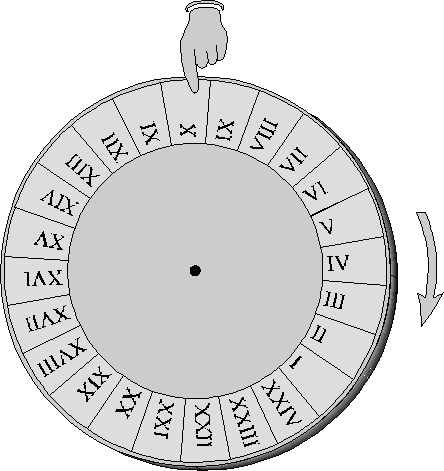
First, we outline the historical developement of astronomical clock dials. All this happened very rapidly, during the 14th century. As soon as the mechanical escapement for regulating the descent of a weight was invented (the verge and foliot, invented round about 1300), people began inventing elaborate clocks. There were clocks before 1300, but they were essentially water-clocks, regulated by the escape of water from a large tank through a narrow pipe - liable to freeze up in winter.
In the second part of this article we look at some outstanding surviving examples of medieval astronomical clocks.
The first clocks had no dial. Their function was to strike a bell at intervals of an hour. Of course the definition of an 'hour' only became hardened into something like our present definition after the spread of the mechanical clock. Before that there was a variety of different systems in use (more on this below).
... then a dial was added. The dial went round, the indicator or 'hand' was fixed. At first the dial was 'not for public use'. It was for the convenience of the clock keeper, reminding him, perhaps, how many times to ring the bell when an hour was up. The clock communicated to the public through the medium of sound, not sight.

Emblem of sun added to the rotating plate. The dial has become fixed. Later this would be called the 'chapter ring'. Sometimes the hours would be numbered from one to twenty-four, at other times according to the English system - two lots of twelve hours (if a bell strikes more than twelve times it is inconvenient to count the number of strikes). In Italy the hours were counted from sunset. But mid-day is a more logical place to start, because the time from one mid-day to the next is almost exactly constant. In any case it was natural to set the sun-plate so that the sun was at the top of the dial at mid-day, since this is the moment when the sun is highest. Clocks had no long-term accuracy in this era, so they needed to be checked at regular intervals by means of a sun-dial.
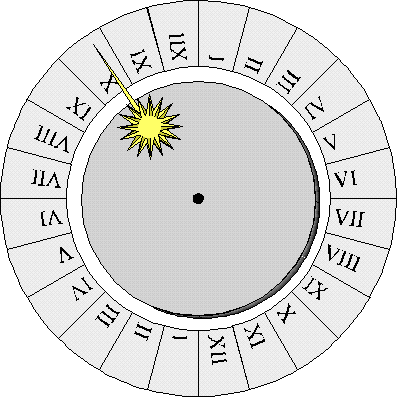
A second rotating plate, the Moon Plate was added. The shafts of the two plates were concentric tubes, supported by a fixed central arbor. The moon plate goes round slightly slower than the sun plate. During the course of a month the moon lags further and further behind the sun, until after 29½ days it coincides with the sun once more.
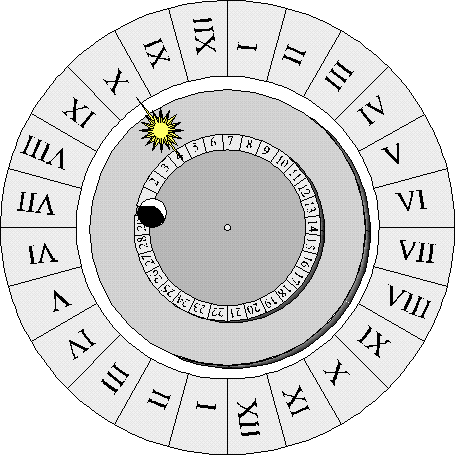
Added refinements:
A third plate, the Zodiac Plate was added. This goes slightly faster than the sun. The stars of the Zodiac gain slightly on the sun each day (roughly one degree per day) so that after a whole year, while the sun has gone round 365 times, the zodiac ring has gone round 366 times. (Leap years posed a problem. The easiest solution was to stop the clock for a day.)
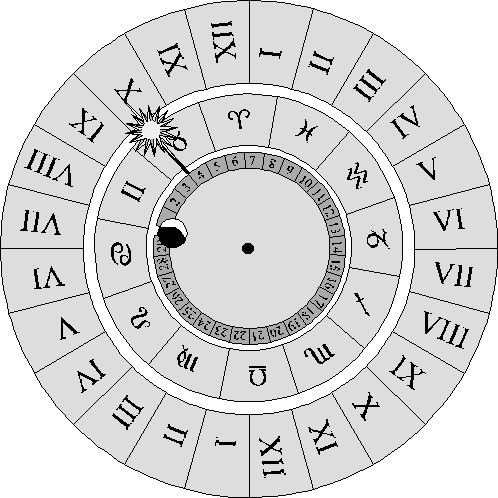
Added refinements:
A variant of the three-plate clock. The constellations of the Zodiac were represented by a circle (the 'rete': light grey in the figure, with zodiac symbols), offset from the centre of the dial . The rete moved over the 'tablet', marked with the horizon (border between dark grey and white) and hour lines. The rete was pivoted at the centre of the clockface, where the two black cross-members intersect, and made one rotation per sidereal day - the same as the zodiac plate in stage 4 (a sidereal day is less than an ordinary solar day in the ratio 365:366, or more accurately 365¼:366¼).
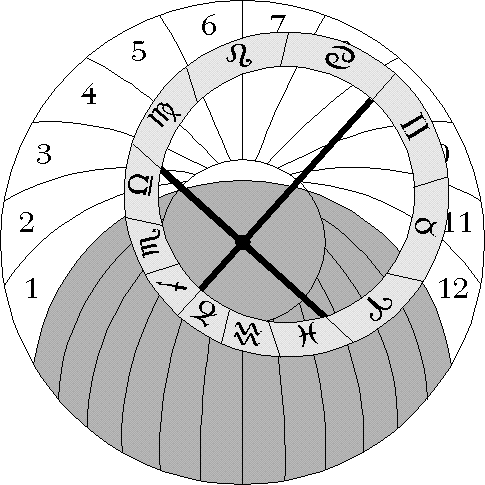
At any moment, six signs of the zodiac are above the horizon (i.e. over the white part of the tablet), six below (over the dark grey part of the tablet). In the figure, the sign of Libra has just risen above the horizon, while Scorpio is just about to rise (or 'ascendant'). Over on the other side of the tablet, Aries has just set, while Taurus is about to set.
The vertical line near the top of the tablet represents the meridian or midday line. In the figure, a point near the midpoint of Leo is transiting the meridian.
The rete turns at a constant rate, but the summer signs (Gemini and Cancer) spend much longer above the horizon than the winter signs (Sagittarius and Capricorn), just as they do in reality. (If the rete takes just under 24 hours to make a revolution, you can see that Cancer, for example, will spend much more than 12 hours over the white part of the tablet.)
Now add a sun hand, as in stage 4, going round once per 24 hours, stretching out to the chapter ring.
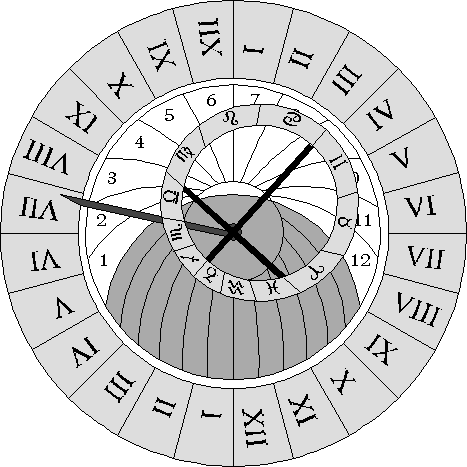
The point where the hand crosses the outer edge of the zodiac ring represents the position of the sun in the sky. It tells us not only where the sun is placed in the zodiac, but where the sun is placed relative to the terrestrial horizon. Note that the sun-hand travels steadily through the Zodiac as the year goes on, spending the same amount of time (roughly a month) in Sagittarius, say, as in Gemini (the opposite sign) - despite the fact that Sagittarius occupies a much smaller segment of the Zodiac circle than Gemini. This is thanks to the fact that the sun-hand is pivoted not at the centre of the Zodiac ring, but off to one side.
A moon-hand may be added in the same way.
In some examples (most famously the clock on the town-hall in Prague) the sun and moon are represented by emblems attached to crank-arms pivoted at the centre of the Zodiac ring, so the emblems are constrained to move around the outer edge of the zodiac ring. But the emblems are actually moved by the sun and moon hands. They are linked in such a way as to allow the emblems to move radially along the hands (some ingenuity is required to ensure that the hands do not interfere with the crank-arms!).
Now you can tell the time not only in the modern way (24 equal hours measured from noon to noon) but also in the old way: twelve day-time hours, measured from dawn till dusk and twelve night-time hours, measured from dusk till dawn. (In summer the day-time hours are longer than the night-time hours, vice versa in winter.) This is the purpose of the hour-lines marked on the tablet. In the figure, the day-time hours have been numbered from 1 to 12. During the day, the sun-emblem will be located in one of the sectors marked off by the hour-lines, and the number of the sector will tell you the hour of the day.